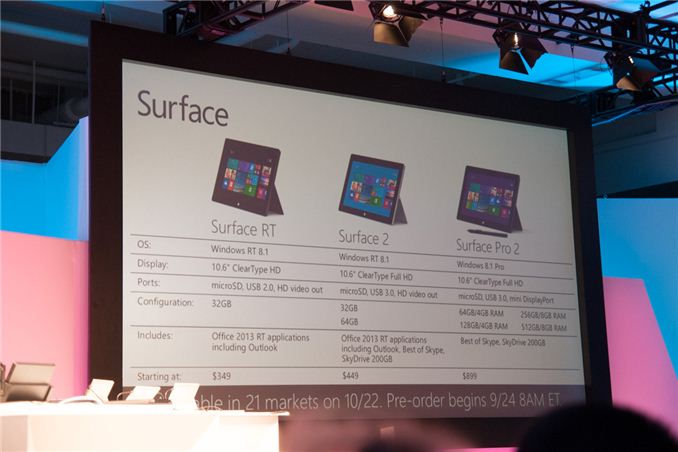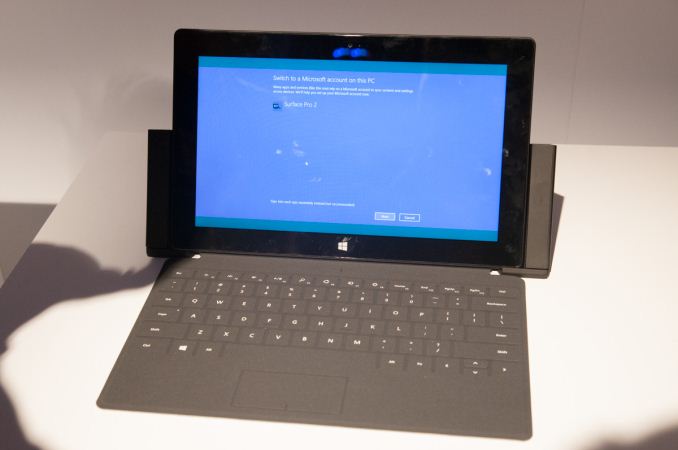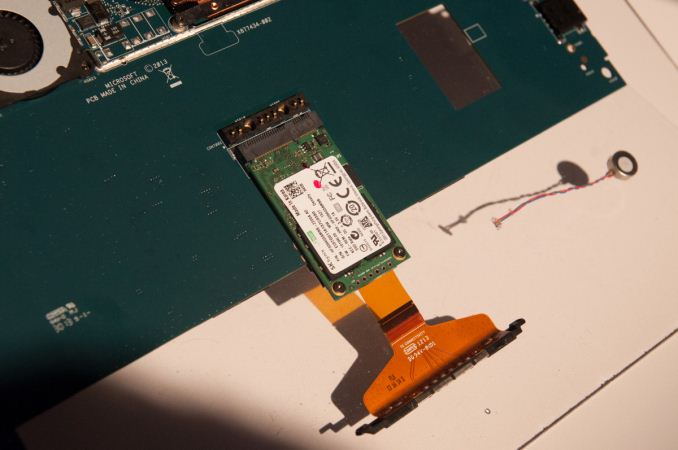Microsoft Announces Surface Pro 2 & Surface 2, Shipping October 22
by Anand Lal Shimpi & Brian Klug on September 23, 2013 12:37 PM EST
Microsoft just announced the long awaited successors to its Surface RT and Surface Pro devices at a press event in NYC. We were fans of the original Surface devices, however neither was quite perfect. It'll be a short while before we can actually review these things (they ship on October 22nd), but on paper we can already get a good indication of what Microsoft has done to both lines.
Surface 2
Surface RT is succeeded (not replaced) by Surface 2. The previous generation Surface RT model will remain on sale for $349, putting it at a very compelling price point in the 10-inch tablet market - especially considering that it comes with a full version of Office. The new Surface 2 takes its place at $449 and features a long list of upgrades. The display is now full 1080p with improved color accuracy compared to the outgoing model. Microsoft spent a lot of time last year talking about how it's 1366 x 768 panel was better than most thanks to its optically bonded display, but it's good to see a shift towards a higher resolution panel. The focus on improving color accuracy is important as well. In our original review of Surface RT I found its display to be ok, but hardly accurate. Given that both Apple and Google are now shipping relatively well calibrated tablet displays, it's key that Microsoft does the same. The only downside is it looks like the new display isn't full sRGB but rather a smaller gamut.
Internally Tegra 3 is out and replaced by Tegra 4. Just like last time, Tegra 4's 5th shadow core isn't exposed or used under Windows RT 8.1. Update: NVIDIA tells us the shadow core is enabled (contrary to what we originally heard from MS at the event), although it won't tell us how it's used. I know I was personally expecting a Snapdragon 800 based device, but those initial rumors also pointed to the Qualcomm based Surface tablet being smaller than 10.6-inches as well so it's entirely possible that we'll see Qualcomm show up at a later point. The move to Tegra 4 comes with four ARM Cortex A15 cores and a much better GPU. The combination of the two should deliver a much better experience on Surface 2 than with Surface RT. The latter was simply too slow, but I'm expecting big things from the Tegra 4 upgrade. Although I completely understand why Microsoft is interested in going with an ARM partner for Surface 2, I do wonder if it might've been a better idea from a power efficiency standpoint to use Intel's Bay Trail instead. Note that with Surface 2 Microsoft drops the RT from the device's name. We'll see what happens with Cherry Trail next year.
| Microsoft Surface 2/RT Comparison | ||||||||
| Surface 2 | Surface RT | Apple iPad 4 | ||||||
| Dimensions | 10.81 x 6.79 x 0.35" | 10.81 x 6.77 x 0.37" | 9.50 x 7.31 x 0.37" | |||||
| Display | 10.6-inch 1920 x 1080 w/ Improved Color Accuracy | 10.6-inch 1366 x 768 PLS | 9.7-inch 2048 x 1536 IPS | |||||
| Weight | Less than 1.49 lbs | 1.5 lbs | 1.44 lbs | |||||
| Processor | NVIDIA Tegra 4 1.7GHz | NVIDIA Tegra 3 |
Apple A6X |
|||||
| Connectivity | 802.11n WiFi | 802.11n WiFi | WiFi , Optional 4G LTE | |||||
| Memory | 2GB | 2GB | 1GB | |||||
| Storage | 32GB or 64GB eMMC | 32GB or 64GB | 16GB—128GB | |||||
| Battery | ? | 31.5 Wh | 42.5Wh | |||||
| Starting Price | $449 | $349 | $499 | |||||
Surface 2 retains the full sized USB port and microSD card slots on the device itself, although the former gets upgraded to USB 3.0. Internal storage options remain at 32GB or 64GB eMMC. Both front and rear facing cameras are improved over the original design as well.
The design of Surface 2 improves over its predecessor. Surface 2 is slightly thinner than its predecessor and is a little lighter as well. The device now features a silver colored VaporMg finish and a 2-stage kickstand. Although I loved the idea of the kickstand with the original Surface devices, I felt that it was often not at the right angle for me to use on anything other than a table. Surface 2's 2-stage kickstand should allow for some flexibility, although I'm curious to see how this works in practice and if there are any sacrifices to the overall stability of the stand.
Surface 2 will ship with Office 2013 RT including Outlook RT and come with 200GB of free Sky Drive storage for 2 years. The entire package starts at $449, but once again does not include a touch or type cover. The 64GB Surface 2 will sell for $100 more at $549.
Surface Pro 2
Surface Pro 2 sees a similar set of upgrades. It gets an updated display (the original Surface Pro was already 1080p) with better color accuracy. USB 3.0 support existed on the previous model as well. The big upgrade here is to a Haswell based Core i5-4200U. That's a 15W Haswell part (similar to what you'd find in an Ultrabook) but with Intel's HD 4400 graphics and not HD 5000. The move to 15W Haswell means there's no real reduction in device thickness with Surface Pro 2. This continues to be an interesting design decision on Microsoft's part. While I'd personally advocate for a lower wattage Y-series SKU, it could be that Microsoft feels the added performance of a full Ultrabook Haswell ULT SKU is necessary for Surface Pro's target market. Either way the move to Haswell should come with significant improvements in battery life (Microsoft claims a 75% improvement for Surface Pro 2, and 25% for Surface 2).
| Microsoft Surface Pro Comparison | ||||||||
| Surface Pro 2 | Surface Pro | Apple iPad 4 | ||||||
| Dimensions | 10.81 x 6.81 x 0.53" | 10.81 x 6.81 x 0.53" | 9.50 x 7.31 x 0.37" | |||||
| Display | 10.6-inch 1920 x 1080 w/ Improved Color Accuracy | 10.6-inch 1920 x 1080 PLS | 9.7-inch 2048 x 1536 IPS | |||||
| Weight | 2.0 lbs | 2.0 lbs | 1.44 lbs | |||||
| Processor | Core i5-4200U with HD4400 Graphics (15W Haswell ULT) |
Core i5-3317U with HD4000 Graphics (17W Ivy Bridge) |
Apple A6X |
|||||
| Connectivity | WiFi | WiFi | WiFi , Optional 4G LTE | |||||
| Memory | 4GB or 8GB LPDDR3 | 4GB | 1GB | |||||
| Storage |
64 or 128GB (4GB RAM) 256GB or 512GB (8GB RAM) |
64GB or 128GB | 16GB—128GB | |||||
| Battery | 42.0 Wh | 42.0 Wh | 42.5Wh | |||||
| Starting Price | $899 | $899 | $499 | |||||
Surface Pro 2 starts at $899 and now comes in four different configurations You can get Surface Pro 2 with a 64GB ($899) or 128GB SSD ($999) and 4GB of RAM, or if you want 8GB of RAM there are 256GB ($1299) and 512GB ($1799) versions as well. Surface Pro 2 retains the old front and rear cameras.
Interestingly enough, the internal shots of the Surface Pro 2 feature a SKhynix mSATA SSD. I wonder if it's using a Link_A_Media controller:
As you can see in the gallery below, the PCB for Surface Pro 2 is absolutely huge. I'm really curious to see why Microsoft went this route vs. trying to fill the device's volume with a battery like most of the other tablet makers. I know in the past Microsoft was very big on weight distribution vs. lower overall weight, but I do wonder if a lighter Surface Pro 2 might've made sense here.
A big part of the Surface story is of course the detachable keyboard covers. This generation both type and touch covers see upgrades. They are both thinner and lighter, and both are now backlit as well. The new touch cover features 1092 sensors (up from only 80 in touch cover 1), which should improve response and accuracy. If you remember back to our original Surface reviews, touch cover accuracy was one of my biggest complaints. It was better than typing on a screen, but not as good as a real keyboard. I'm wondering if the new design helps here at all.
The type cover sees a 1mm reduction in key travel, which helps reduce thickness of the cover itself (although potentially at the expense of typing feel). You can also now get the type cover in four different colors as well (purple, pink, blue and black), instead of just black like the original design.
Other accessories include a new power cover with integrated battery, a docking station, and a music kit that replaces the traditional keyboard with something optimized for music playback/remixing.
Both Surface 2 and Surface Pro 2 will be available for pre-order starting tomorrow, with devices available on October 22nd.


























89 Comments
View All Comments
Borkmier - Tuesday, September 24, 2013 - link
Yeah, an Atom based system would be far cheaper, at least $300.00 cheaper, to produce than the Surface Pro 2. Then again, even the best Atom is not a processor I would ever want to use. Given the choice between an Atom based machine I can buy, but don't want to use, and a Surface 2 Pro that I want to use, but can't afford to buy, I'll just stick with my laptop, which already does everything I need.Doominated - Tuesday, September 24, 2013 - link
You've been able to find brand new Ultrabooks for ~500 pretty much all year this year. What do you mean it "hasn't happened yet"? It's happened exactly like Intel said it would.James5mith - Monday, September 23, 2013 - link
Isn't that CPU the same as in the new Haswell NUC?rituraj - Monday, September 23, 2013 - link
Why the hell is there so much maxiPad talk. It's Anandtech. Readers are supposed to make sense. I am a bit disappointed that even Anand and Brian puts this in the same comparison table with an ipad. I would like to see comparison with a samsung ativ pro or thinkpad helix along with a MB Air.The surface pro is by no means In the league of ipad and the likes. It's an ultrabook that has a digitizer input, tablet form factor, x86, windows 8.1 with full office (you know it's pricey), a keyboard etc.. etc....
This is not your average media consumption device. Its is nearly a mobile workstation (well not exactly) for digital artists, photographers, engineers, school and college teachers, students and so many other professionals. The arm based products are no where near it when it comes to serving those professions.
Impulses - Monday, September 23, 2013 - link
Digital arts, photographers, and teachers aren't gonna drive sales in a significant way tho, they 're borderline niche... Students and mobile pros are where I see the Surface Pro's biggest market but even amongst them some may prefer a larger laptop or a smaller tablet. At least Pro has a viable and untapped market tho, anything RT is just doomed IMO.Impulses - Monday, September 23, 2013 - link
Bay Trail convertibles running x86 Windows OTOH can tap an even larger market, dunno why MS elected to push another overpriced RT hybrid atop an existing one that isn't selling.Nagorak - Monday, September 23, 2013 - link
Microsoft really dropped the ball in regards to the Surface 2. Not only is Baytrail a competitive processor, it means that the tablet can be full Win 8.1 instead of RT. Microsoft keeps pushing RT and the fact is no one wants it. A few diehard fanboys will go on about how it's fine, but the public at large has shown they are not interested.Even if they had to increase the cost by $50 or $100, going with Baytrail and full Win 8.1 would be more than worthwhile. Bottom line: Surface 2 should be called Surface RT2, the price should be $100 lower, and the real Surface 2 should use a Baytrail Atom processor and be full Win 8.1. If they can't make a Tegra 4 Surface RT for $350 then they should just can the whole thing. Hardly anyone is going to be interested in paying for a WinRT tablet when there will be competing Win 8.1 tablets that cost less, and probably offer better performance with Baytrail anyway.
Qwertilot - Tuesday, September 24, 2013 - link
Slightly doubt that. Processor performance roughly equivalent but surely RT is a substantially lighter weight operating system than full Win 8.1 so you end up faster in practice. Or did they mess that up too?Dayv1d - Wednesday, October 9, 2013 - link
MS clearly did not WANT full win for the surface 2. Especially not as limited in performance as it would be with an atom. The Device is meant to be a tablet in the sense of an ipad, just more eficient if it comes to getting things DONE so its the first (!) all in one device for people who just uses computer for standard tasks like consume media, surf, use social nets, mail, skype, take notes etc who would so far have to take an ipad AND a netbook / cheep laptop (or maybe just an ipad, but would sometimes have a damn hard time with it writing and multitasking).And than there is the pro, which is the all in one for everyone else, who really needs a full pc with all that software.
I think the main difference between ms and Apple right now is, that apple wants you to buy many different products (and sync them over their cloud), while ms thinks one computer should suffice one person (+ maybe a phone, because calling / making pictures with a 5"+ device is just ridiculous!).
I mean, somewhere in time arm based ipads really have fulfilled its temporary purpose of filling the gap of a portable desktop, because desktops really HAVE BECOME portable. And guess what, the pro is right that. Its just a little fat, though. :P
And i also think, that the not-so-good selling numbers are neither a sign of an unfunctional system including the "win rt has too few apps" prob (reviews really prove that it allready already does well in most tasks) nor shows that people does not want / need that whole product family at all. Its just a LOT harder to hit a saturated marked with already two working platforms in it, than one that is still in phase of early development. Its even harder than ms thought it would be...
jasonelmore - Tuesday, September 24, 2013 - link
looking at the pics it looks like it has two 31.1 whr batteries